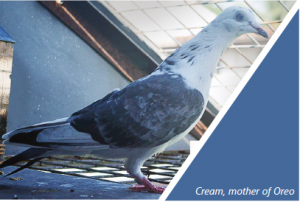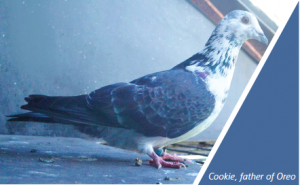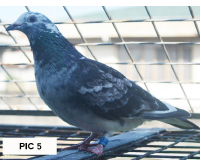Breeding pigeons can be fun and challenging. Here are a few tips on how to get started.
Even after three decades of being a pigeon fancier, every loft visit of mine holds the same excitement for me. Main loft activities are feeding, cleaning, observation, and loft flying. Loft flying is watching our pigeons flying around their loft in a group. Each pigeon has its unique personality when it comes to flying. It also serves as their exercise regimen.

Ideally, to do this, we need young birds to train. We buy from either other fanciers or breed on our own. When fanciers are ready for another challenge, to take things to the next level, they go on to pigeon racing. Breeding pigeons is exciting and challenging at the same time. One of the challenges is having an ideal system in an urban environment. Many fanciers swear by their breeding system, to the point of complication.
For years, I have the privilege of exchanging ideas with seasoned fanciers and a common denominator I notice is their simplicity of breeding practices. I am an advocate of making things simple. It is easier to modify, improve, and share with other fanciers.
Simple Breeding System
Common terms used:
• Banding – placing a ring band on squeakers. A ring band becomes lifetime identification for the bird once it grows.
• Ring band – generally made of aluminium and coated with resin plastic, this contains a serial number, year, and club name. Sometimes fanciers will customize ring bands with their own names.
Squab or squeakers – birds which are not able to feed to feed themselves yet.
• Young bird – a bird that already knows how to feed itself. Almost all its feathers are complete and it is ready for flight training.
• Cock – male pigeon• Hen – female pigeon• Pedigree – ancestral record• Offspring – animal’s young
Benefits of Breeding on Your Own
• You create our own pedigree
• You can track the genetics you desire, such as color, size, and performance pattern
• Future crossbreeding reference
 Items Needed for Breeding
Items Needed for Breeding
• Breeding cage with minimum dimensions of 30 in x 18 inch x 16 inches. The standard cage used for lovebirds, but with a divider, is ideal. Anything smaller makes it uncomfortable for the mated pigeons and will cause them stress.
• Nest bowl – an inexpensive clay pot from any garden store is ideal. Some fanciers use plastic basin or biscuit containers, and these work well for them. I wrap the clay nest bowl with old newspaper; it is easier to clean since the dirt will not stick to the clay pot, which is porous.
• Feeder and drinking bowl
• Fine sand – found in local hardware stores. This is the same sand used for building construction. It makes for an inexpensive and effective nesting material; just make sure the sand is dry.
• Food – Pigeons are grain eaters. Most poultry stores have pre mix called “breeder mix.” Pigeons also need clean water and should be fed daily. Include grits daily.
Pairing and Conditioning
• Sexual maturity – When pigeons reach about five to six months of age, they may breed all year round. Many fanciers, however, prevent them from breeding continuously for conditioning and timing of race purposes.
• Sexing – There is no 100 percent sure way to identify pigeon’s gender but there are many indicators for determining this. Also, through experience, a fancier can easily identify a cock or hen.
• Cocks are generally bigger than hens. The head of the male pigeon is bigger too. During courtship, the tail of the cock will drop down and it will make an action that seems like it is sweeping the floor. His head will bow down and up and he will move in a circling fashion. The cooing sound it creates is much louder than a hen’s. Sometime, it charges and pecks the hen to show dominance.
• Hens are smaller in stature and their heads are smaller. They are more timid and if it has an intention to accept the male as a mate, it walks in a graceful manner. Sometimes, a fancier will feel the vent (DEF) to check if it has a wider gap. Unless you decide to breed them, it is best to separate the cock and the hen. Separating them will lessen the aggressiveness of the cocks and prevent stressing the hen. Space is maximized since paired pigeons tend to be territorial.
Upon pairing, place the hen and cock in a cage with dividers. The cock will be able to see the hen and it will start courtship. Deworming at this stage is advisable. After three to five days, if the birds shows interest in each other, they will try to be together even with the dividers in place. Remove the dividers if this happens. If the cock pecks and puts too much pressure on the hen, they are not ready to breed.
Mating Behaviors
• Both pigeons will make “kissing” gestures. The hen will lower herself to allow the male to mount her.
• When both are inside the nest bowl, the cock then positions his head to the hen’s vent region. He also creates a wooing sound. It indicates that he is calling for the hen to lay eggs.
• Start picking hay or twigs as nesting material. The finished nest is a beautiful sight to see. I suggest using half an inch of dry fine sand.
Breeding
• Place the nest bowls inside the breeding cage; ensure there is fine sand. Some fanciers place the nest bowls in the midpoint of the cage. This is good in case the fancier decides to continue breeding for the second clutch. The squab or squeakers will be placed on the floor and learn to eat. It is also this time that another set of eggs are normally laid. The squeakers will not be able to disturb the nesting hen or cock.
• Females lay their first egg about 10 days after mating, usually in the late afternoon or early evening. A second egg is laid after 2 days. Two eggs is the normal clutch size. Incubation commences with the laying of the second egg. Both parents will take part in the incubation. The cock bird usually sits on the eggs from 10 a.m. until 5 p.m. The hen then sits the rest of the time. Avoid disturbing the birds during the incubation and rearing period.•Hatching normally occurs 18 days from start of incubation.

Both parents feed the squeakers. They feed their young on a glandular crop secretion called “pigeon milk.” They continue to feed their young until they learn to eat by themselves. Squeakers will start feeding themselves at around 3 weeks of age. When the young birds start feeding themselves, check their wings. When all primary feathers are complete and fully grown, it is now ready for the next step, which is flight training.
Banding – use a club ring band if you are a member or a commercial one available at your local poultry store. Band your bird on the 8th to 10th days. Banding too early means the band will tend to lose its hold; banding too late will result in the band not fitting anymore. Do not force the ring band on because this will injure the bird’s legs. Ring bands are very important, as they are your bird’s unique identification. You cannot race a bird without a ring band
Common Breeding Problems
• The second birds are often smaller and will sometimes die because of its larger nest mate sibling. These can avoid if parents are bred at the right age and are healthy. Some birds have low parental instincts; if this is the case, I suggest discontinuing their use for breeding. If you want to get the bloodline of the bird, use foster parents.
• Squeakers are prone to suffer from canker disease. To prevent this, make sure all dishes, water, and food are clean.
• Other birds bully squeakers who start feeding themselves. This happens in a breeding colony set up. The single breeding cage eliminates the problem. Using the simple breeding system, I shared the knowledge of breeding with my kids. We started with young birds and because of their color, we call them Cookies and Cream.
When the birds reached adulthood, we bred them. We have successfully reared one offspring, which we called Oreo. It was an enjoyable family bonding activity. I brought Oreo to the office where my loft is located and had it flight trained. Now I bring Oreo home and fly it back to its loft at the office.
Breeding pigeons is not rocket science. What works for one might not for another. Keep it simple; stick to the basics, and improve on them.
This appeared in Animal Scene’s May 2016 issue.






